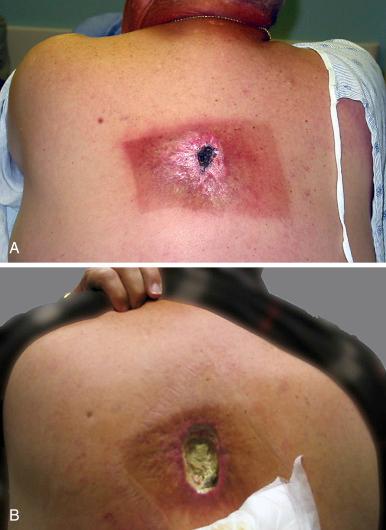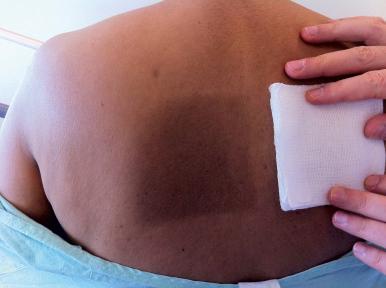Physical Address
304 North Cardinal St.
Dorchester Center, MA 02124
Interventional cardiologists who use fluoroscopy should be familiar with radiation risks and should know how to manage radiation appropriately.
Incidents of patient skin injury following fluoroscopy-guided interventional procedures have been reported. Many reported skin effects resulting from fluoroscopic procedures were inadvertent, because the physician was unaware of the radiation dose and consequences.
Interventional cardiologists must receive training in selection of appropriate fluoroscopic equipment configuration and utilization of dose-management tools. This training should include both general radiation dose-management practices and specific practices for the model of fluoroscopic equipment and personnel radiation protection tools they will use.
Strategies for minimizing patient radiation dose include using a low dose rate and a low frame rate for fluoroscopy, keeping the image receptor close to the patient, using collimation and moderate x-ray beam angles, and minimizing fluoroscopy time and image acquisition.
The cumulative radiation dose display provided by the fluoroscopic equipment should be utilized to keep track of patient dose.
If reference point air kerma (kinetic energy released in material) exceeds 5 Gy for a procedure, the interventional cardiologist should inform the patient that a radiation skin effect may occur and provide appropriate follow-up.
Personnel present during fluoroscopy procedures should use x-ray shielding and should move back from the patient during fluoroscopy to reduce their radiation exposure.
Fluoroscopy-guided interventional cardiovascular procedures provide substantial benefit to patients by relieving symptoms, improving quality of life, and replacing the need for open surgical procedures. These procedures include vascular, electro-physiology, and percutaneous structural heart interventions. Procedure risks may also be substantial and include stroke, myocardial infarction (MI), renal failure, and death. The ionizing radiation required for fluoroscopic guidance in each of these types of procedures also carries risk, particularly for prolonged procedures and obese patients. These radiation risks include radiogenic cancer and skin injury, although many other procedural risks are significantly greater than the radiation risks. Nevertheless, it is important to apply the basic principles of radiation protection for medical exposure to patients. These principles are justification —that is, use of radiation should provide more benefit than harm to the patient, and the procedure should be medically indicated—and optimization , meaning the patient dose should be managed to be commensurate with the medical purpose, and unnecessary radiation exposure should be avoided. To follow these principles, practitioners who use fluoroscopy should be familiar with radiation risk and should know how to manage radiation appropriately.
Two types of health effects result from radiation exposure, stochastic and deterministic. Stochastic effects include cancer and genetic mutations. These effects are caused by damage to cell DNA. Because an effect may result from misrepair of a single cell, stochastic effects are independent of the amount of radiation exposure and are thought to have no lower threshold limit. Deterministic effects are tissue reactions from radiation exposure. The severity of tissue reactions increases with dose, and a minimum dose exists below which no observable effect occurs. Tissue reactions of concern related to fluoroscopy use include skin burns, hair loss, and cataracts.
Radiation-induced cancer risk has been studied extensively in many different exposed populations, including survivors of the atomic bomb detonations over Hiroshima and Nagasaki in World War II, patients receiving medical treatments, and workers exposed to radiation. Although the relationship between cancer induction and radiation exposure has been well established for high doses, cancer risk at low dose levels, such as those encountered in diagnostic imaging or from natural sources, is uncertain. Because the latent period for most cancers is long, and the natural incidence of cancer is high, it is difficult to determine cancer risk levels for whole-body doses less than approximately 100 mSv (which is equivalent to the radiation delivered during several complex percutaneous cardiac interventions [PCIs]). As a result, a model is used to estimate cancer risk at low doses from observed high-dose cancer rates. The commonly accepted linear nonthreshold model predicts a fatal cancer risk of 5% per Sv whole-body exposure for a working-age adult. Typical effective dose values (estimation of whole-body dose from a partial body exposure) are 15 mSv for PCI, 7 mSv for diagnostic coronary angiography, 7 mSv for chest computed tomography (CT), and 0.1 mSv for a chest radiography exam. For comparison, natural background radiation levels in the United States average about 3 mSv/year.
Genetic mutations from radiation exposure have been found in animal studies, but no human study has demonstrated any effect. Although radiation-induced heritable effects were initially thought to be a significant radiation risk, it is now accepted that the genetic risk is minimal.
Skin injury from radiation exposure has been thoroughly characterized for radiation therapy patients. Although fluoroscopy x-ray energies are lower than high-energy radiation therapy x-ray beams, skin effects and threshold dose levels are similar to that of orthovoltage radiation therapy (50 to 250 kilovolt peak [kVp]; Table 7.1 ). Transient erythema may occur within 24 hours after a radiation dose of 2 Gy or more. Between 2 and 8 weeks from an exposure, epilation may occur with main erythema present for doses greater than 5 Gy, and desquamation may occur for doses greater than 10 Gy. Longer term, for doses greater than 15 Gy, dermal atrophy and secondary ulceration may occur that may require surgical treatment. Examples of fluoroscopic skin injuries are shown in Figs. 7.1 and 7.2 . It should be noted that time intervals and dose thresholds given in Table 7.1 are approximate and will vary depending on the patient’s health, location of the exposed area, and condition of the lesion. Other factors may also be associated with increased skin response to irradiation, including diseases such as diabetes mellitus and hyperthyroidism and also ataxia, telangiectasia, connective tissue diseases, and exposure to various chemotherapy agents.
| Band | Single-Site Acute Skin-Dose Range (Gy) a , c , d | NCI Skin Reaction Grade | Approximate Time of Onset of Effects a , b | |||
|---|---|---|---|---|---|---|
| Prompt <2 Weeks | Early 2–8 Weeks | Midterm 6–52 Weeks | Long-term >40 Weeks | |||
| A1 | 0–2 | Not applicable | No observable effects expected at any time | |||
| A2 | 2–5 | 1 | Transient erythema | Epilation | Recovery from hair loss | None expected |
| B | 5–10 | 1–2 | Transient erythema | Erythema, epilation | Recovery; at higher doses, prolonged erythema, permanent partial epilation | Recovery; at higher doses, dermal atrophy or induration |
| C | 10–15 | 2–3 | Transient erythema | Erythema, epilation; possible dry or moist desquamation, recovery from desquamation | Prolonged erythema, permanent epilation | Telangiectasia, e dermal atrophy or induration, skin likely to be weak |
| D | >15 | 3–4 | Transient erythema; after very high doses: edema and acute ulceration, long-term surgical intervention likely to be required | Erythema, epilation; moist desquamation | Dermal atrophy; secondary ulceration due to failure of moist desquamation to heal, surgical intervention likely to be required; at higher doses, dermal necrosis, surgical intervention likely to be required | Telangiectasia, e dermal atrophy, induration; possible late skin breakdown; wound can be persistent and may progress into a deeper lesion; surgical intervention likely to be required |
a The dose range and approximate time period are not rigid boundaries. Also, signs and symptoms can be expected to appear earlier as the skin dose increases.
b Abrasion or infection of the irradiated area is likely to exacerbate radiation effects.
c Skin dose refers to actual skin dose (including backscatter). This quantity is not air kerma at the reference point (K a,r ).
d Skin dosimetry based on K a,r or air kerma area product (P KA ) is unlikely to be more accurate than ±50%.
e Refers to radiation-induced telangiectasia. Telangiectasia associated with an area of initial moist desquamation or the healing of ulceration may be present earlier.


Although rare, skin injury following fluoroscopy-guided interventional procedures has been reported. Many of these injuries involve complex cardiology procedures such as PCI for the recanalization of chronic total vascular occlusions and radiofrequency ablations. A rise in the number of reports to the U.S. Food and Drug Administration (FDA) in the early 1990s led to the release of a public health advisory in 1994. Injury may also result from multiple procedures, even if individual sessions are below the threshold for skin effects. When exposure of the same skin location occurs over several episodes, injury threshold doses will depend on the dose level and the time interval between procedures. It should be noted that many reported skin effects resulting from fluoroscopic procedures were inadvertent, and the physician was unaware of the radiation dose delivered. As a result, patients were not made aware of the potential for skin injury, which caused a delay in the diagnosis of their wound. Skin biopsy should not be performed in areas of suspected radiation skin injury because this leads to a delay in healing and/or to secondary infections. Recording of patient dose, communication with the patient, and follow-up for significant dose levels are important radiation management methods that will be discussed later in this chapter.
Procedure optimization includes limiting radiation dose to a level that is as low as possible to accomplish the clinical task. This process requires attention to imaging equipment configuration and to radiation dose management practices. Interventional fluoroscopy systems contain many components that work together to form an image. For the most part, adjusting components to increase radiation dose will result in improved image quality. Although at first glance achieving excellent image quality may appear to be the aim of procedure optimization, this objective will generally result in an unnecessary dose. Instead, the appropriate image quality level that is clinically acceptable should be the goal so that an appropriate radiation dose can be used. Some tasks within an interventional procedure can be accomplished using an image with reduced radiation dose and image quality. Whenever possible, equipment configurations with a lower dose rate should be selected. This is best accomplished by adjusting initial settings to a low dose rate before a procedure begins, then selecting higher dose-rate settings as needed in a limited fashion for a specific imaging task, such as placing a guidewire or deploying a stent, where high spatial resolution and low image noise are needed. Further details about fluoroscopic equipment components will be covered in the next section of this chapter.
Staff training is an important component of procedure optimization. Operators of fluoroscopic systems are in charge of the amount of radiation used during a procedure, which affects the dose to the patient, to themselves, and to other staff in the procedure room. It is important that operators receive training on how to select appropriate equipment configurations and how to utilize dose-management tools. Additional information regarding the components of this training are provided in this chapter.
Because fluoroscopy-guided interventional procedures have the potential to deliver patient radiation dose levels that can cause skin injury, it is important that the fluoroscopic equipment used be suitable for the task. Several key equipment features are desirable to ensure proper management of patient and staff radiation dose. Some of these features include digital image acquisition, variable-rate pulsed fluoroscopy, added x-ray beam filtration, and patient radiation dose display. Safe and effective patient care in complex interventional procedures is best realized when appropriate equipment is used. Fluoroscopy systems that comply with International Electrotechnical Commission (IEC) standard IEC-60601-2-43 for interventional equipment include these and other elements appropriate for interventional procedures.
Become a Clinical Tree membership for Full access and enjoy Unlimited articles
If you are a member. Log in here